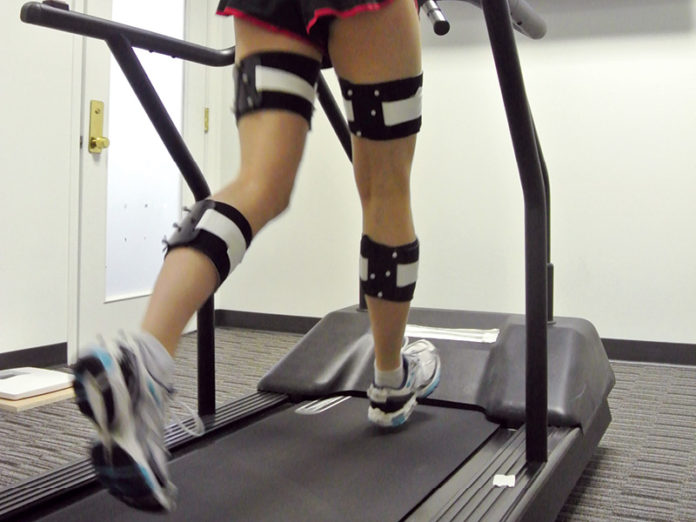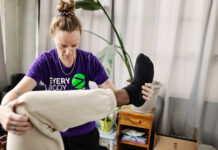
Research over the past 35 years has clearly established that half of all runners will sustain a chronic overuse injury each year. In Canada, that’s almost 3 million runners each year!
What’s also known is that half of all running injuries occur at the knee and the most common injury is patellofemoral pain or runner’s knee. This common injury is best described as the kneecap not sitting properly within the groove of the femur (your thigh bone) and the atypical alignment results in repeated stress and pain. You’ll most commonly feel a dull ache under the kneecap when out for a run and that pain is worse when running up and down stairs, squatting or jumping. The pain generally gets worse immediately following a run and over the next few hours. You’ll also commonly feel this dull ache after you’ve been sitting for a long period of time. So what can you do about it?
Traditionally, exercises to strengthen the muscle around the knee have been prescribed to stabilize the kneecap.While most patients have successful short-term outcomes with this program, follow-up studies ranging from five to 25 years after rehabilitation have shown that more than 90 per cent of runners report a return in their symptoms.
Recent research from our lab at the University of Calgary and labs around the world, has clearly pointed to hip muscle strengthening as a better rehab approach. Rather than focusing on controlling the kneecap, increased hip muscle strength serves to control your femur and improves your overall running biomechanics.
Researchers at the Running Injury Clinic recently completed a four-year study investigating optimal treatment methods for patellofemoral pain. This study was the largest and most comprehensive to-date and involved 199 runners across four research centres in Chicago, Georgia, Milwaukee and Calgary. We compared a novel hip and core-strengthening program that we developed to the standard of care knee-focused approach. This hip-core program focused on strengthening the hip musculature, improving core endurance, as well as improving overall balance.
The results were quite fascinating. During the six weeks of rehab, the hip-core group had significant improvements in their pain and function only three weeks into treatment. Those involved in the knee program didn’t show the same improvements until the four-week mark. Most fascinating was that the hip-core program resulted in greater gains in muscle strength in all muscle groups (hip, core and knee) whereas the knee rehab program only resulted in small improvements in knee muscle strength and had no effect on the hip or core.
This is Level 1 evidence that if you are experiencing runner’s knee, the hip-core program developed by our Clinic gets you back running one week sooner and results in greater gains in strength compared to the standard of care approach. It is also important to keep in mind that if you have runner’s knee, you should be significantly better after three to four weeks of treatment and you should be pain-free after six weeks of rehab. If your knee pain isn’t getting better, a more specialized and scientific approach may be necessary to understand the root cause of your injury.
Gait Analysis Can Predict Injury
The most specialized and scientific approach to determine the root cause of an injury is through a 3-dimensional (3D) gait analysis, which measures how you run with millimetre accuracy. It helps determine your likelihood for injury and the best rehabilitation approach if you are injured.
Our studies have involved sophisticated machine-learning mathematical techniques, involving hundreds of runners, to understand the complex association between pain resolution, improvements in muscle strength and changes in running biomechanics.
Where this gets exciting (if machine-learning math isn’t exciting enough!) is if you are experiencing runner’s knee, we have developed a method that takes your 3D gait data and, with 87.8 per cent accuracy, we can predict the ideal treatment to resolve your pain.
Some of the most important biomechanical factors that are fed into the prediction algorithm include the amount of hip collapse immediately after the foot strikes the ground and also just before toe-off along with the angle of foot pronation just after midstance. This represents a complex association among many variables but this type of research and using this technology is a big step forward towards the goal of precision medicine and making sure that you’re getting the right treatment at the right time.
How to Build Strong Hips
Here are 3 of the primary exercises used in the hip-core rehabilitation program.
For each exercise:
- Begin by setting the core and pull your belly button in toward your spine.
- Use a smooth controlled motion throughout a full range of motion.
- Work up to 3 sets of 10-15 repetitions.
- Perform these exercises daily and always after a run or workout.
Gluteus Medius Strengthening
- Place opposite foot behind band.
- Move involved leg outward, keeping knee straight.

Hip-Core Internal Rotation
- Stand with involved leg rotated outward at 45 degrees, with band around the front at hip level.
- Move the involved leg forward while internally rotating, keeping the knee straight or with slight “soft knee”.

Core Stability — One Leg Balancing
- Stand on pillow or foam pad with one foot.
- Balance for 30 second intervals.
- Repeat 3 times.
- Repeat for other foot.
- Use light touch on a wall initially to help balance.
- Perform with eyes closed to add more difficulty.

Go to runninginjuryclinic.com for videos and tips on how to perform these exercises.
















